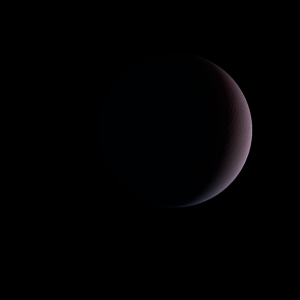|
|
Space Astro
|
Info for exoplanet "Kanesho-ru"
| Scientific (actual) data |
|---|
| Planet | OGLE-2018-BLG-1700L b |
| Planet status | Confirmed |
| Planet mass | 4.4 |
| Semi major axis | 2.8 |
| Discovered | 2019 |
| Updated | 2019-09-12 |
| Publication | Published in a refereed paper |
| Detection type | Microlensing |
| Mass detection type | Microlensing |
| Star name | OGLE-2018-BLG-1700L |
| Right ascension | 269.95° |
| Declination | -28.53° |
| Star distance | 7600 |
| Star mass | 0.54 |
| Wikipedia article | OGLE-2018-BLG-1700L b |
Back
| |
| Fictional info (?) |
|---|
| Suggested name | Kanesho-ru |
| Planet type | Large cold gas giant |
| Kanesho-ru is similar in composition to Hyubumya Mabu, and both have different bulk chemical composition from that of the larger large cold gas giants. This large cold gas giant is named after the deity Kanesho-ru, the spirit of the sea.
Kanesho-ru's surface appears slightly cratered and is similar in appearance to the Moon's, indicating that it has been geologically inactive for billions of years.
Kanesho-ru is by far the hottest planet in its solar system, with a mean surface temperature of 239°K (-34°C).
As one of the most prominent objects in the sky, Kanesho-ru has been a major factor in native culture for as long as records have existed. It has been made sacred by members of many cultures, and has been a source of inspiration for musicians, calling it the "fallen light".
The volume of water detected has been estimated to be equivalent to the volume of water in the Black Sea.
Its apparent magnitude reaches -3, which is surpassed only by Hyubumya Mabu, Tashu Chunyu, and OGLE-2018-BLG-1700L.
The latest probe to visit the planet is Racer, which entered into orbit around Kanesho-ru after a somewhat troublesome trip.
The surface of this arid planet is occupied by small primitive plants that spend their life close to volcanos while hunting something called Resabya at night. They are believed to be related to the Nunemu, have fur and vary in size from 11 to 14 cm. They can survive temperatures from 40 to 130°C and even even a limited degree of radiation. |
| Estimated population | 150000000 |
| Atmosphere | Water | 47% |
| Oxygen | 34% |
| Methane | 18% |
| Carbon dioxide | 0.38% |
| Atmospheric pressure | 0.0013 bar |
 |
| No known satellites |
| Google search for Kanesho-ru |
|
Website by Joachim Michaelis
|
|
|
|